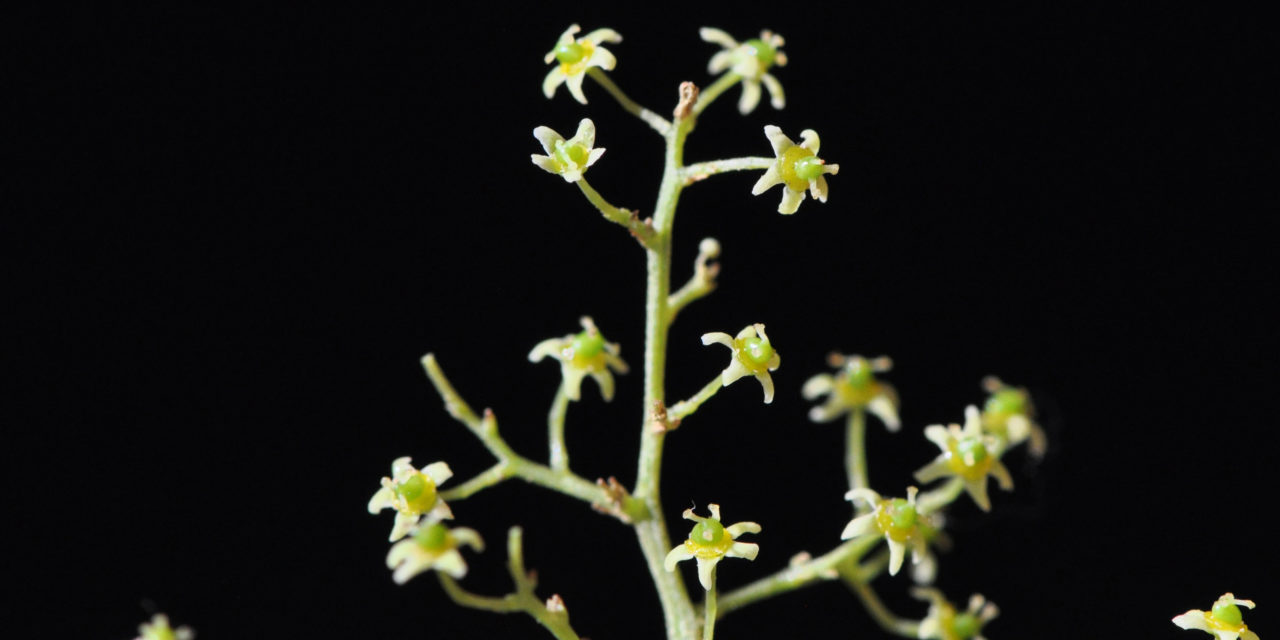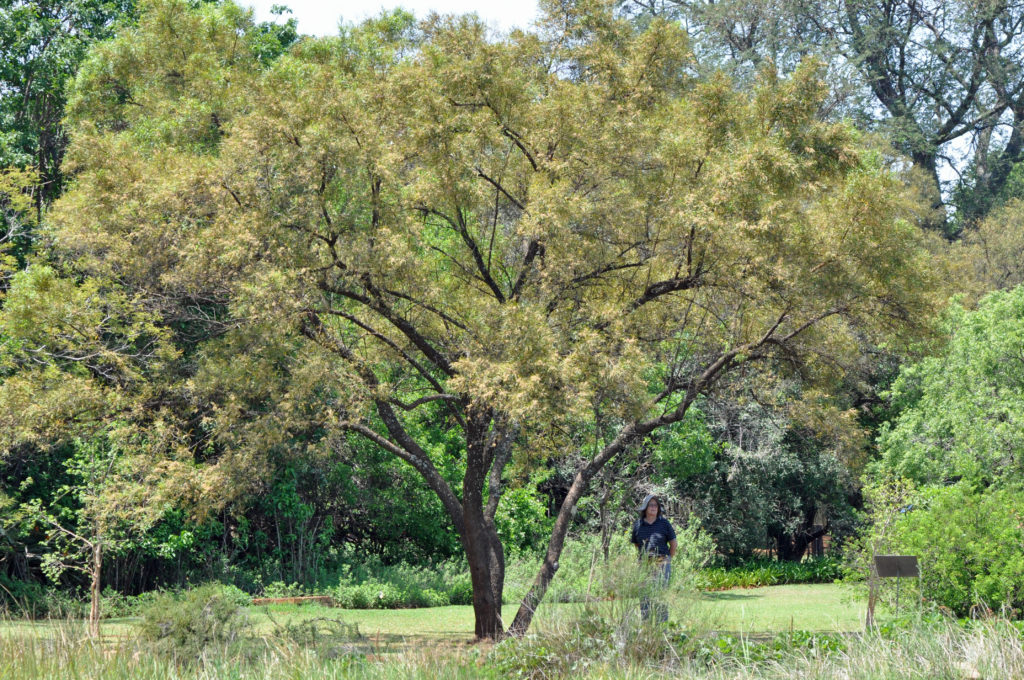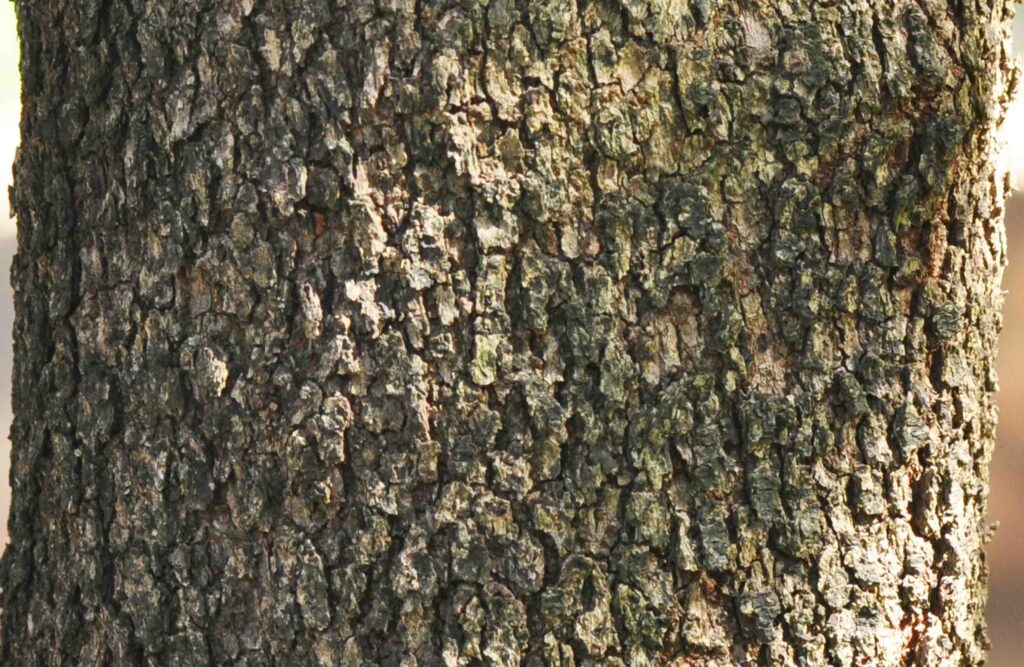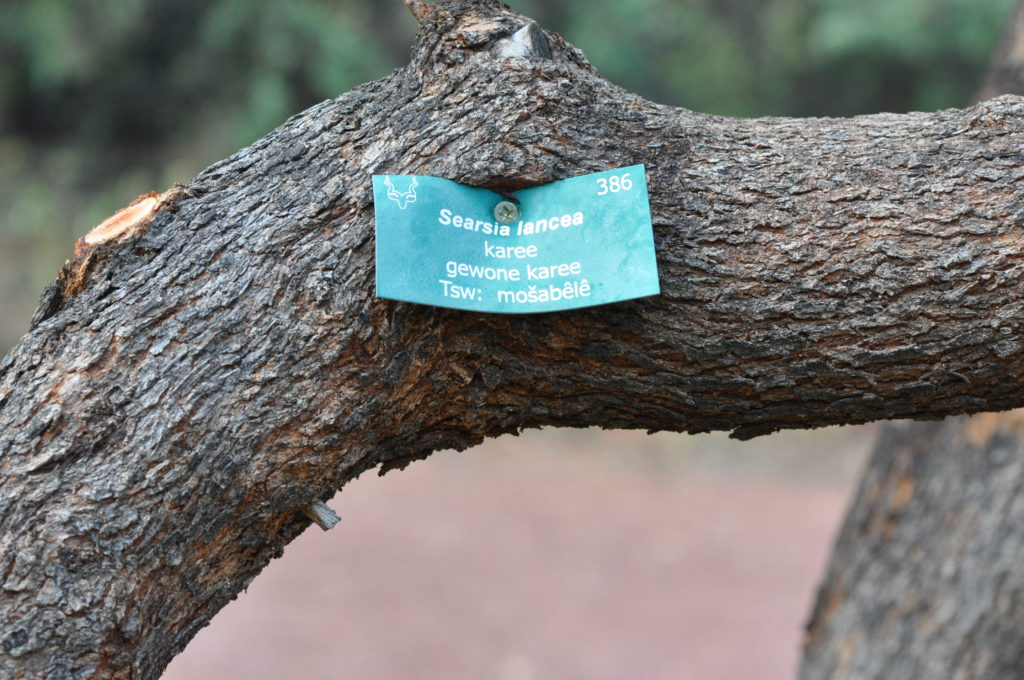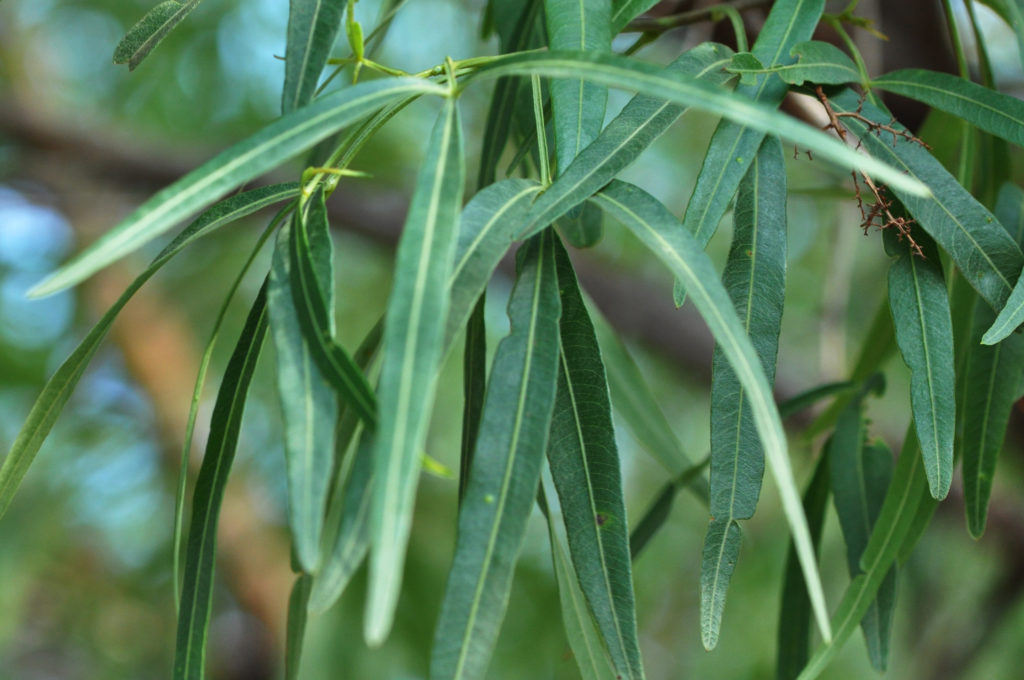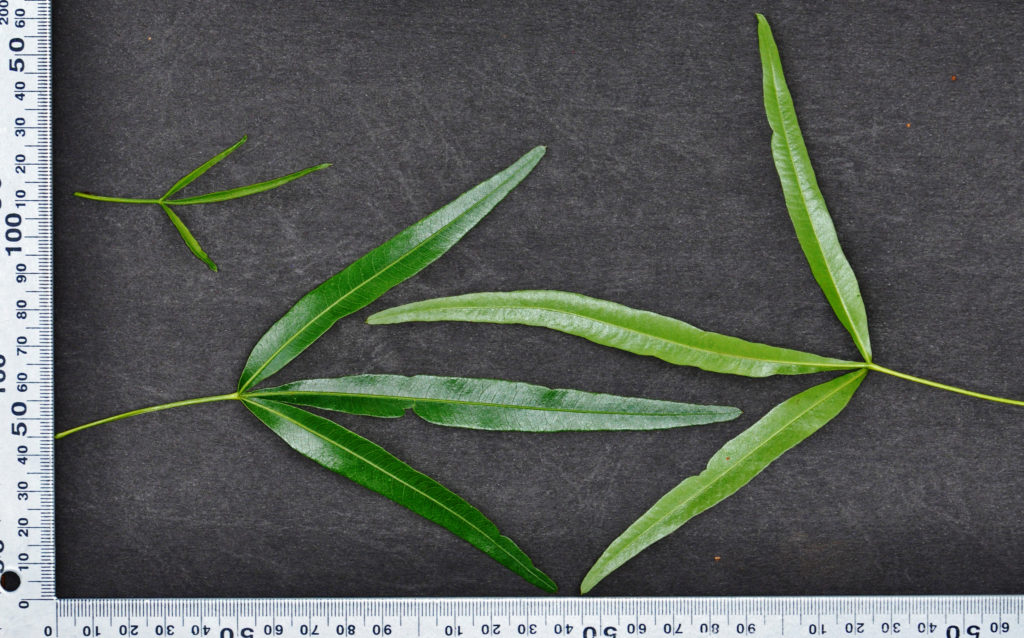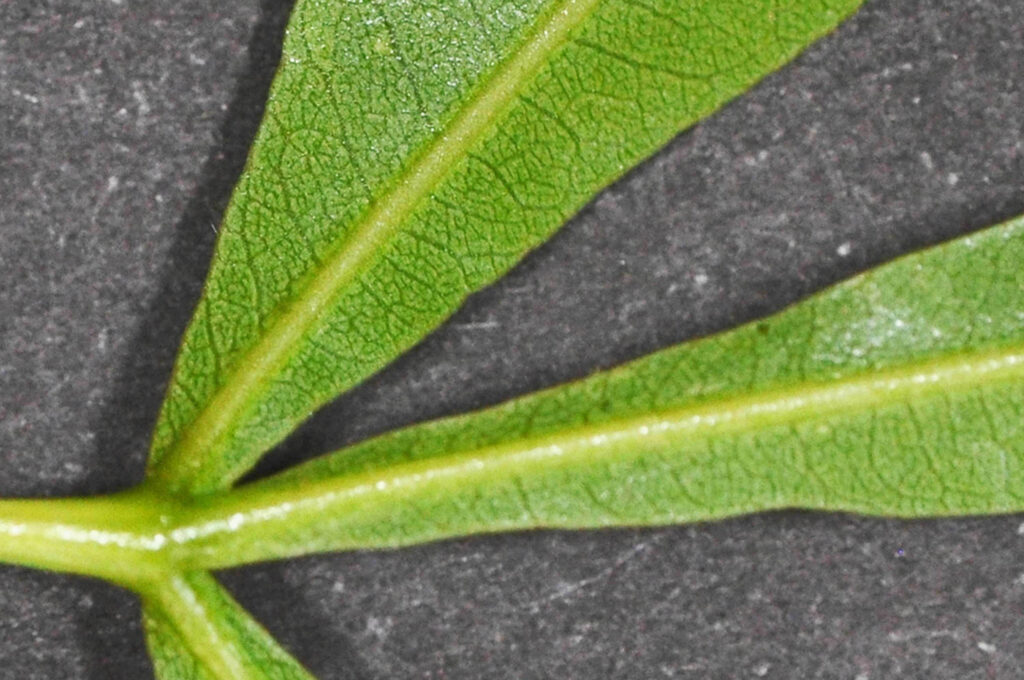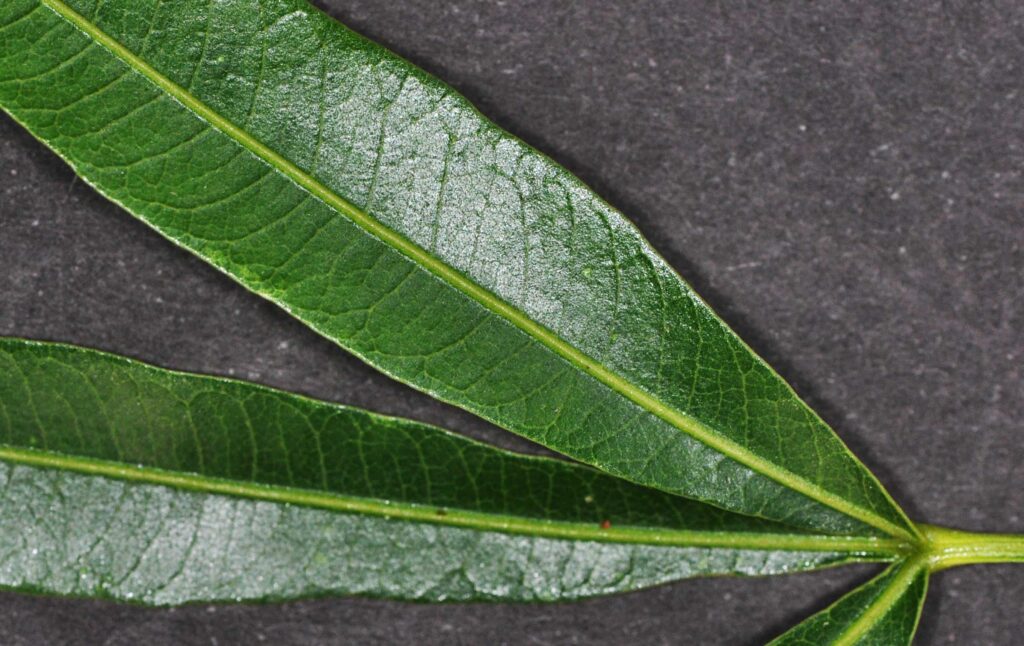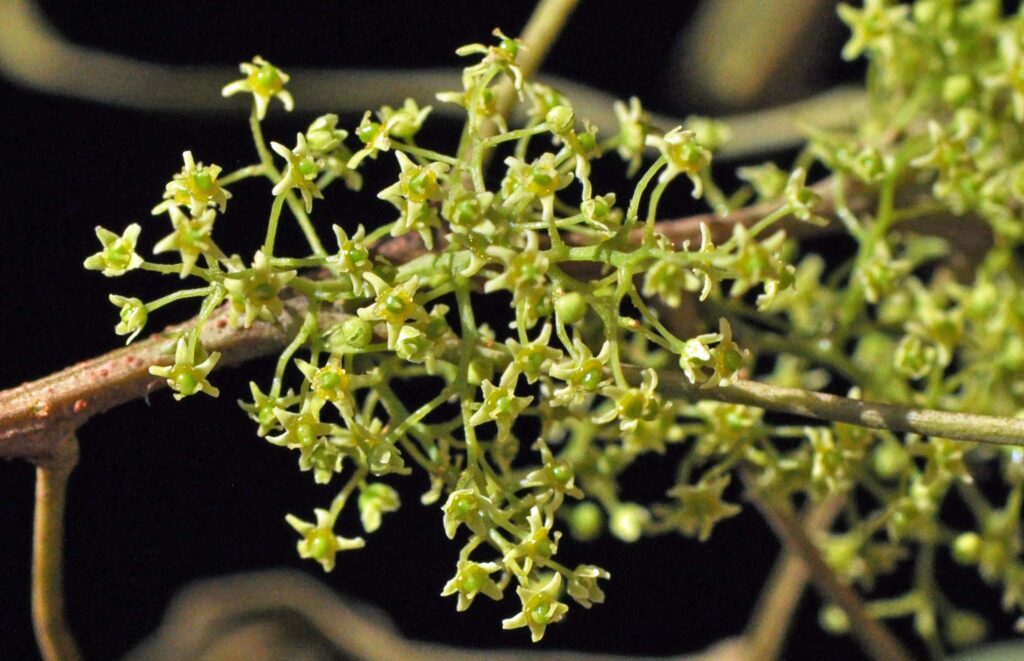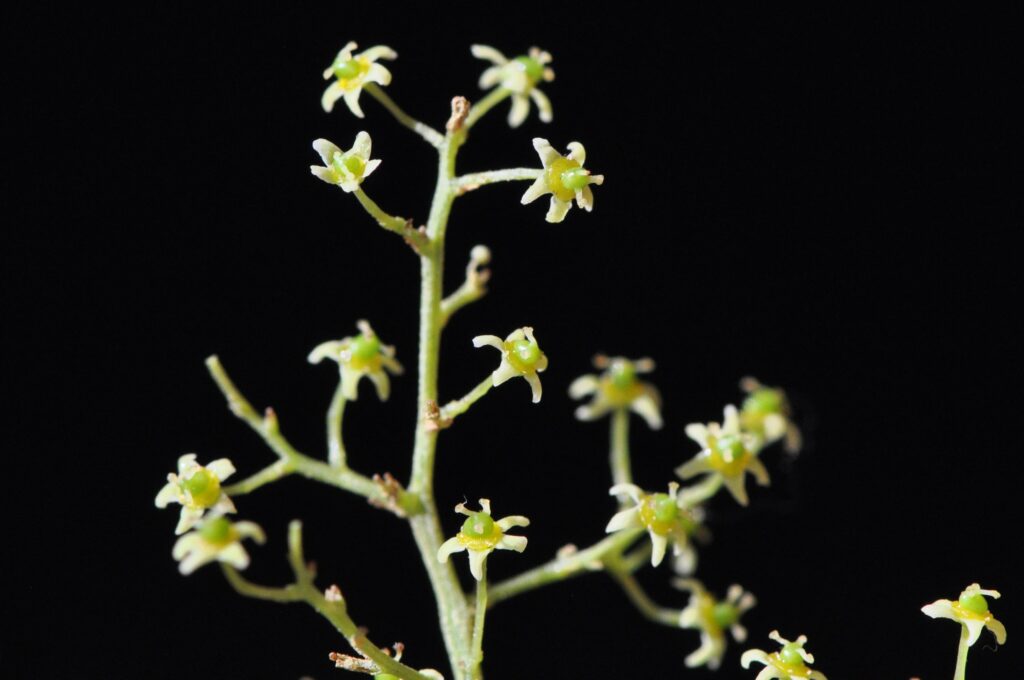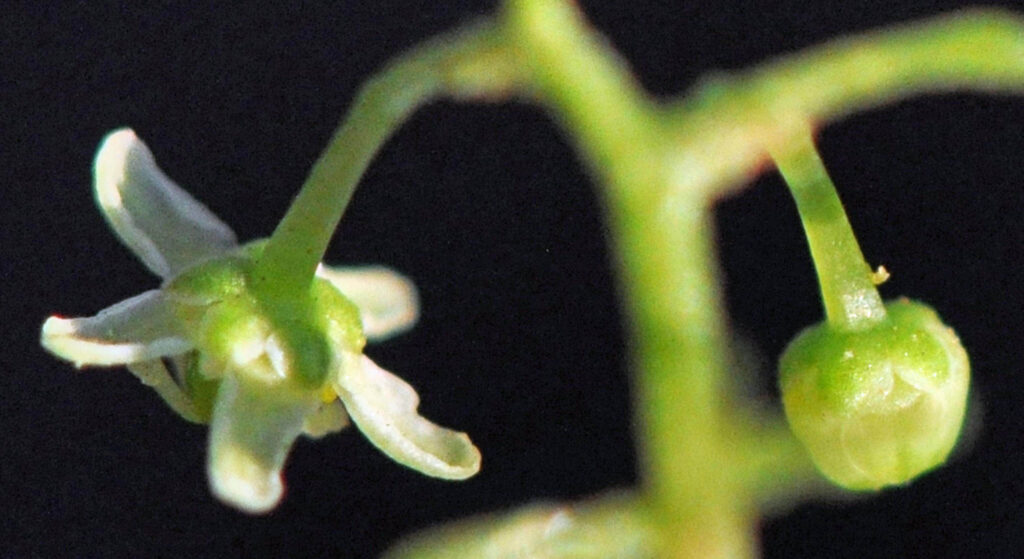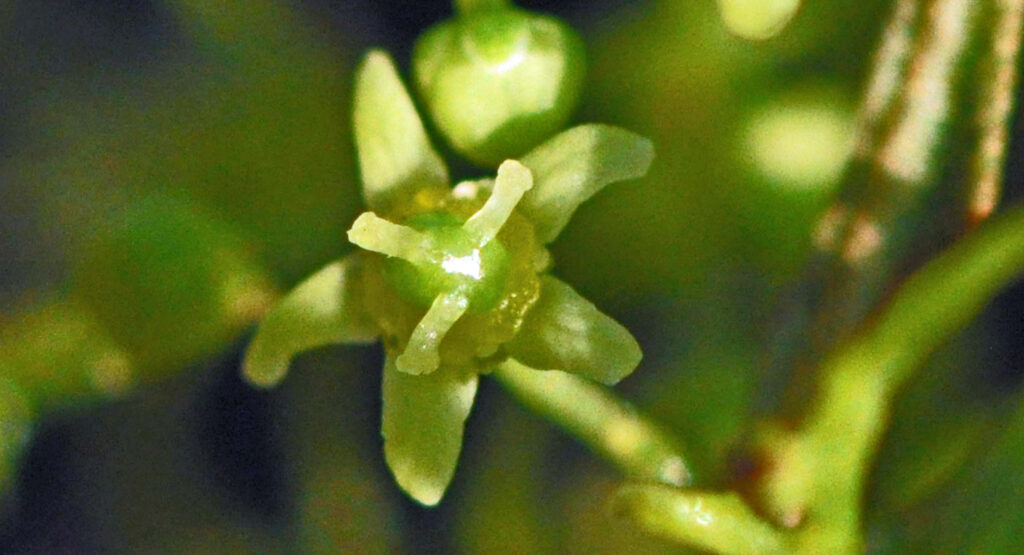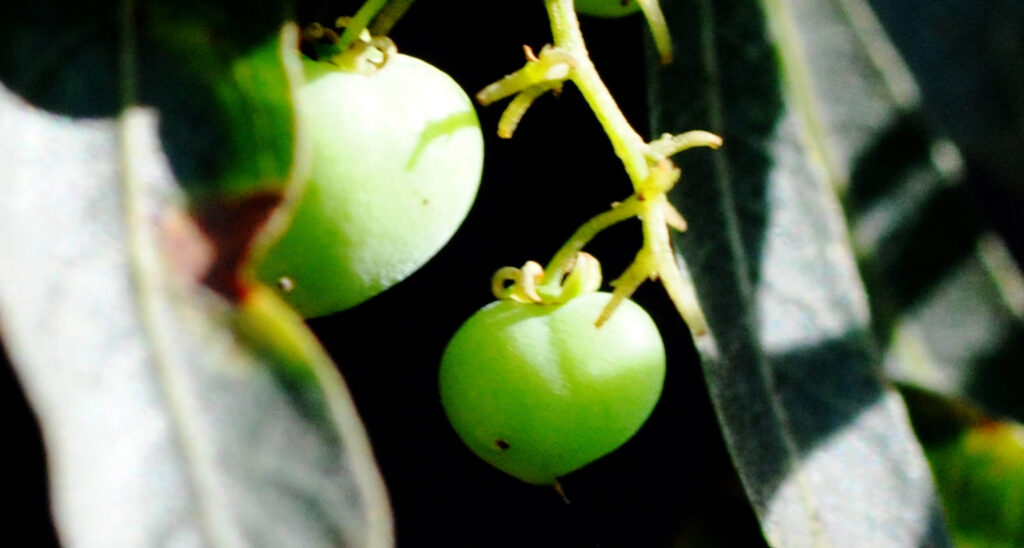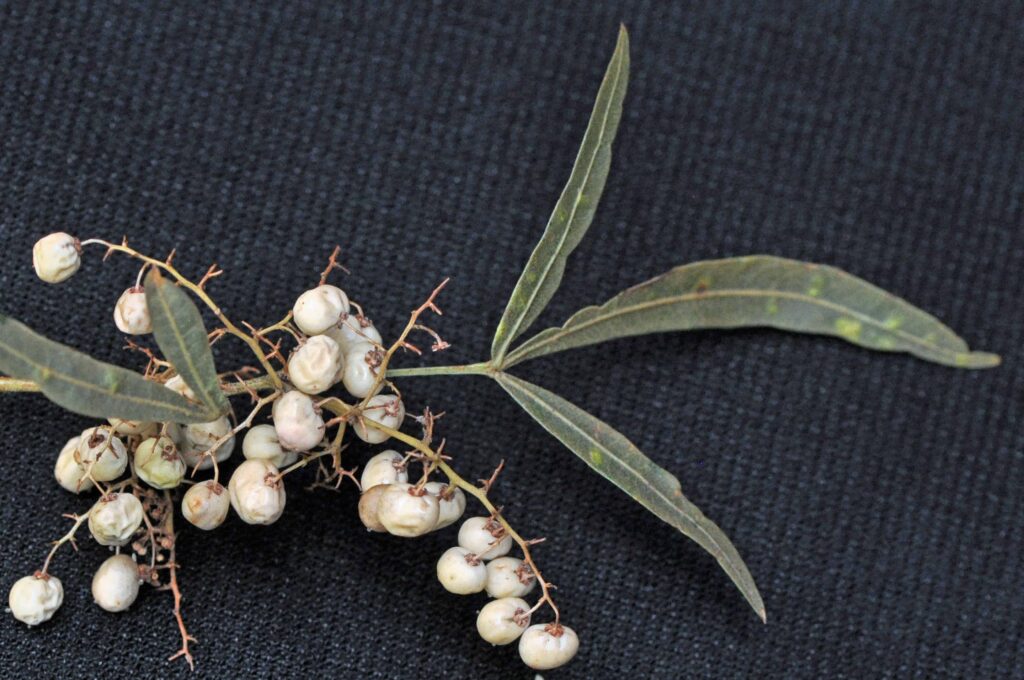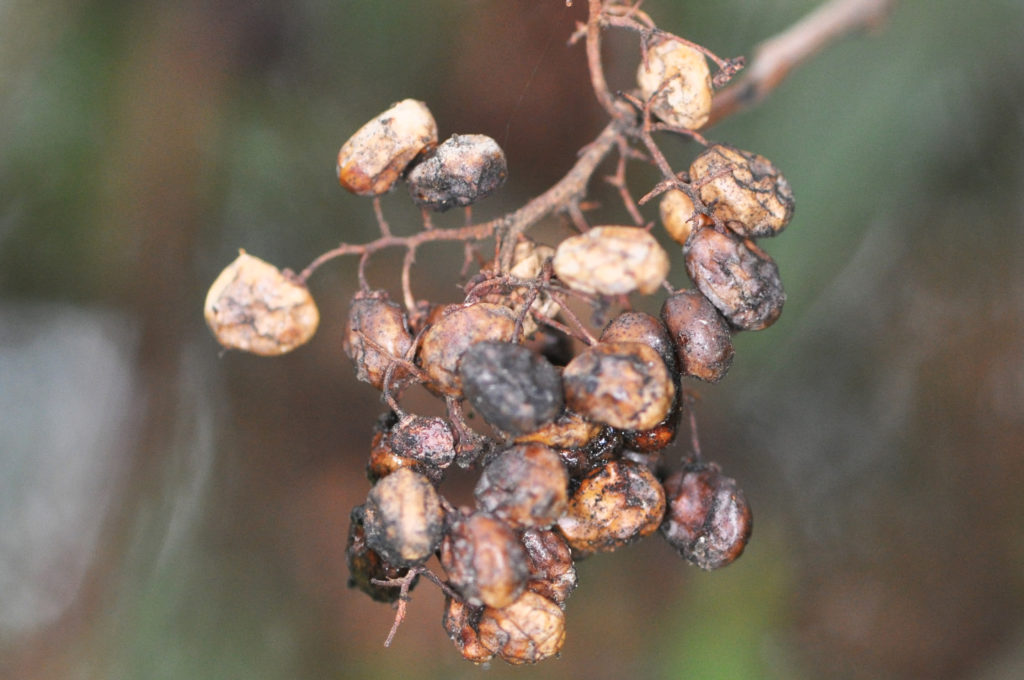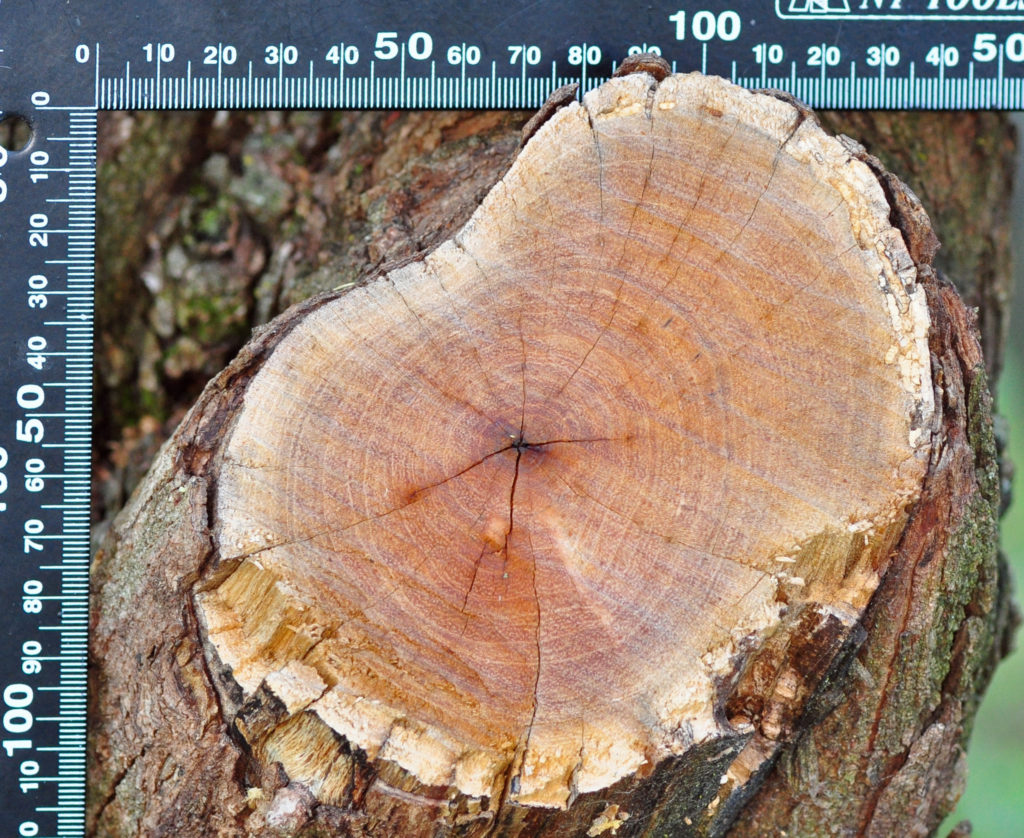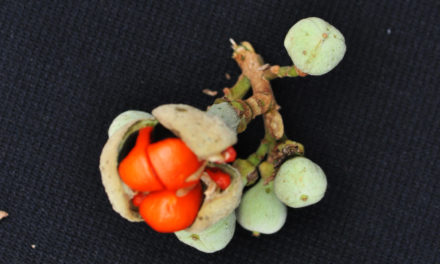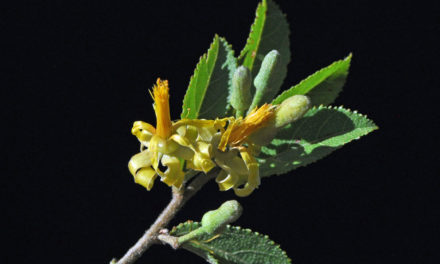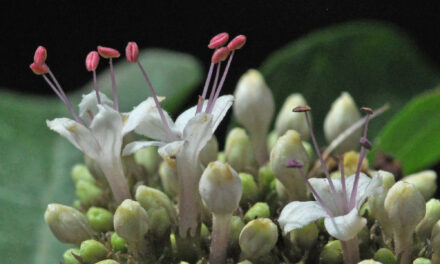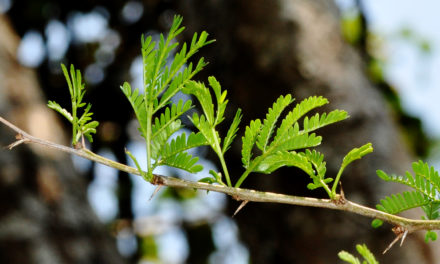General Info – summary
This dioecious Tree is up to 9m high; with its brown/black fissured bark. Branches are reddish. The usually evergreen tree has trifoliate Leaves, no stipules or petiolules & leaflets are narrow and usually lanceolate. Tiny yellowish, regular 5-merous Flowers in panicles. Male 5 stamens and female has 1 pistil, a superior ovary and 3 distinct styles. Fruit is a small 1-seeded drupe with a persistent recurved calyx.
Description
Searsia lancea
Previous Names: Rhus lancea, Rhus viminalis.
SA Tree No. 386.
Common names: (Afr) Karee, Karree, Rooikaree, Taaibos. (Eng) Bastard willow, Karoo tree, Karee, Willow Searsia. (isiXhosa) Iqunguwe. (isiZulu) Inhlokoshiyane. (Northern Sotho) Motlhotlho, Mohlwehlwe, Mokalabata. (Setswana) Mosilabele, Mosilabelo. (siSwati) Inhlangutshane.
Family: Anacardiaceae. (Mango family), which has about 83 genera and 850+ species – including Cashew). About 80 species occur in South Africa. Hunting arrows have been made from straight stems. Resin canals are present and woolly stellate hairs cover all young parts. Leaves lack stipules. They may be deciduous or evergreen and usually alternate. Leaves are simple, trifoliate or digitally compound and imparipinnate. Leaflets are usually opposite. Crushed leaves may smell of turpentine. Trees are monoecious or dioecious with occasional bisexual Flowers. Flowers are small, greenish or yellowish white and usually regular. The Calyx has 4-7 sepals and there are 4-7 Petals. The number of Stamens is the same as, or twice the number of petals and the Anthers are versatile. The superior Ovary has up to 4 locules, each with a single ovule. The 1-5 Styles are free or connate and separated at the base. Fruit is usually an indehiscent fleshy drupe that provide food in dry areas. They contain a single quick growing Seed. The southern Africa genera containing trees on this website include Harpephyllum, Lannea, Loxostylis, Ozoroa, Sclerocarya and Searsia.
Name derivation: Searsia named after Paul Bigelow Sears – a highly qualified American ecologist (December 17, 1891 – April 30, 1990). He pioneered the study of fossil pollen in the USA. lancea – lance-like (referring to the shape of leaflets). There are many species of the genus Searsia in southern Africa. The common name “karee” is derived from the Hottentot name (Khoi peoples originally part of a pastoral culture and language group to be found across southern Africa, is thought to refer to a population originating in the northern area of modern Botswana). DNA research has confirmed difference between European Rhus and our Searsia.
Conservation: National Status: L C. (Least Concern). Assessed: 2018 (L. von Staden).
Tree
This often twisted, well-rounded Tree (photo 574) is usually up to 9m tall (but may reach 12m) and has a spread of 6m or more (photo 574). The Bowl (stem or trunk) may be twisted and crooked. The plant may also develop into a scrubby bush. The Bark is dark brown (photo 122) to blackish and becomes rough and irregularly fissured (photo 310). In older trees the trunk is often twisted. The Branches (photo 574) tend to droop. Lenticels (a usually raised corky oval or elongated area on the plant that allows the uncontrolled interchange of gases with the environment) are present on the youngish reddish brown branches (photo 52).
- 574. 2014/10/30. Pretoria NBG. Photo: David Becking.
- 122M. 2014/06/03. Walter Sisulu NBG. Photo: David Becking.
- 310. 2014/02/20. Marakele NP. Photo: David Becking.
- 52. 2017/06/02. Linden. Photo: David Becking.
Leaves
The alternate or spirally arranged Leaves are trifoliate (compound leaves with 3 leaflets – photo 313). The hairless, slightly stiff, smooth and slightly leathery leaflets are dark, shiny olive green above and slightly paler and yellowish green below (photo 347). A shiny resinous exudate (a liquid or semisolid that has been discharged through the tissue) is often present on young leaves. Leaflets have a resinous smell when crushed (easy to test). The leaves tend to droop gracefully (photo 313). Each Leaflet is fairly stiff and linear to narrowly lanceolate (lance-shaped). Apart from very cold conditions, this tree is evergreen and only sheds old leaves when the new leaves appear. The central/terminal leaflet is the largest – up to 13 x 1,2cm (photo 347). Leaflets may be slightly sickle-shaped (photo 347). Veins are best viewed with the aid of a hand lens against a strong light. The parallel side veins may loop around and join up before reaching the margin. The raised Midrib is visible on both sides and more raised below. The lateral veins protrude slightly on the upper side (photo 348). On the lower side, only the midrib protrudes and here the net veins are more obvious (photo 349). The Apex is narrowly tapering and may be mucronate (ending in a small hair like tip). The Base is narrow and tapering to cuneate (wedge shaped). The untoothed, slightly thickened Margins are usually entire (with a continuous margin, not in any way indented – photo 347). The thin Petiole (leaf stalk) is up to 1-4cm long. It is not winged and is slightly grooved above – close to the blade (photo 348). Stipules (basal appendage of the petiole) and Petiolules (leaflet stalks – photo 349) are absent. From late summer to early winter, the leaves may develop a yellowish tinge.
- 313. 2014/02/20. Marakele NP. Photo: David Becking.
- 347. 2014/10/24. Linden. Photo: David Becking.
- 349. 2014/10/24. Linden. Photo: David Becking.
- 348. 2014/10/24. Linden. Photo: David Becking.
Flowers
These trees are dioecious (male and female flowers occur on separate trees). The tiny, sweetly scented, unisexual Flowers are actinomorphic (Regular, symmetrical. Flowers are vertically divisible into similar halves by more than 1 plane passing through the axis). The very small flowers are pale yellow-green and arranged in Panicles (indeterminate, branched inflorescence with stalked flowers – photos 50 & 46). Panicles occur axillary or terminally. These sprays of flowers are up to 9cm long. Each flower has 5 green Sepals which are joined at the base (photo 164) and the 5 larger Petals are free (photo 164). In Male Flowers, the 5 Stamens have free filaments. Their Anthers have 2 Thecae (pollen sacs) that dehisce longitudinally. The ovary is lacking but a rudimentary pistil is present. The Female Flowers have a single Pistil (a unit of the Gynoecium, the female element of the flower, which is composed of the Ovary, Style and Stigma). Here the superior Ovary has 3 free Styles (Photo 159). Also visible on this photo is the disc (a more or less fleshy or elevated development of the receptacle). Usually 5 Staminodes (sterile stamens) are present. (Apr-Sep).
- 50M. 2017/06/02 Linden. Photo: David Becking.
- 46. 2017/06/02. Linden. Photo: David Becking.
- 164. 2018/05/30. Linden. Photo: David Becking.
- 159. 2018/05/30. Linden Photo: David Becking.
Fruit
The small: 4-6mm in diameter, slightly compressed and slightly asymmetric Fruit is an almost spherical hairless Drupe (a fleshy, 1-seeded indehiscent fruit with the reniform seed enclosed in a stony endocarp; stone fruit – like a peach) surrounded with a thin fleshy layer. A persistent recurved Calyx is visible on young fruit (photo 1196). The fruit changes from green to a reddish brown, to white (photo 362) and finally to a shrunken dull whitish yellow or brown (photo 629). (Sep-Jan).
- 1196. 2015/08/18. Walter Sisulu NBG. Photo: David Becking.
- 362. 2015/11/21. Linden. Photo: David Becking.
- 629. 2017/01/31. Pretoria NBG. Photo: David Becking.
Distribution & Ecology
This plant is now a street tree in Kimberley. It is a survivor and can live for 100 years or more. In dry areas, like the Highveld it is common along riverbanks, near underground water or on koppies (small, often slightly isolated natural hills rising up from the flattish African veld). It also occurs in the bushveld. Plants often occur in calcareous (mostly or partly composed of calcium carbonate) layers. They are drought, termite and frost resistant and most noticeable in dry areas. Here the dark, shiny olive green leaves contrasts with much of the surrounding vegetation and the tree is valued for its shade. This tree is found in most of South Africa – in the Western Cape, Eastern Cape, Free State, Gauteng, Limpopo e.g. Pilanesberg, Mpumalanga, Northern Cape and North West. It is not common in KwaZulu-Natal. It also occurs in Zimbabwe, Botswana, Zambia and Namibia. This tree often grows together with Vachellia karroo (Acacia karoo) but usually closer to water. This is most noticeable in arid areas because its roots do no not penetrate as deeply as those of Vachellia karroo. Many animals browse Leaves – especially in the dry season. These include kudu, roan antelope and sable antelope. The sweetly scented Flowers attract insects – including bees.
Ethnobotany
This Tree is a possible indicator of underground water. It is drought and frost resistant, and serves as a protection for nearby frost sensitive and shade plants. It occurs in a wide variety of habitats and altitudes. The tree may be planted to serve as a wind barrier. The Roots are non-invasive. The red-brown close-grained Wood (photo 403) is hard and dense (up to 970kg per cubic metre at 10% moisture content). It is durable, polishes well and has a pleasant smell – but is often twisted and may splinter. Wood is used to make pick handles, fence posts and for firewood. The flexible Branches are used to make baskets. Bushmen once used the supple branches to make their bows. Flowers attract birds, bees and other insects and, as a result, even more birds. Birds include bulbuls, francolins, and guineafowl (in the family Numididae). All the indigenous Searsia species in South Africa have edible fruit that are rich in carbohydrates. The Fruit is edible but not great tasting. Fruit pounded with water is used make a pleasant beer. The fruit makes an excellent poultry feed. However, our parrot (African grey) was not very impressed. The fruits are usually rubbed between the hands to remove the tough skin before they are eaten. They may also be soaked in milk. The Bark is used for tanning and has in-vitro antibacterial activity. The plant has been introduced into desert regions in Mexico and the USA (here it is called African sumac or willow Rhus). Propagation is easy by cuttings and truncheons. All work well but both male and female trees are required for fruit production. Selected cuttings, that will provide trees of both sexes, are recommended. For this reason, Seeds are not encouraged. This plant is widely planted and relatively fast growing from cuttings.
- 403. 2017/10/10. Walter Sisulu NBG. Photo: David Becking.
References
Coates Palgrave, M. 2002. Keith Coates Palgrave Trees of Southern Africa, edn 3. Struik, Cape Town.
Palmer, E. & Pitman, N. 1972. Trees of southern Africa. Balkema, Amsterdam, Cape Town.
Schmidt, S. Lotter, M. & McCleland, W. 2002. Trees and Shrubs of Mpumalanga and the Kruger National Park. Jacana, Johannesburg.
van Wyk, B. & van Wyk, P. 1997 Field guide to Trees of Southern Africa. Struik, Cape Town.
von Staden, L. 2018. Searsia lancea (L.f.) F.A.Barkley. National Assessment: Red List of South African Plants version 2020.1. Accessed on 2023/12/03.
http://plantzafrica.com/plantqrs/searsialancea.htm
https://en.wikipedia.org/wiki/Paul_Sears
http://www.greenaplanet.co.za/blog/searsia-lancea-karee-a-practical-tree
https://en.wikipedia.org/wiki/Rhus_lancea
http://www.calflora.org/cgi-bin/species_query.cgi?where-calrecnum=12012
http://www.prota4u.org/protav8.asp?en=1&p=Searsia+lancea
http://posa.sanbi.org/flora/browse.php?src=SP
https://en.wikipedia.org/wiki/Khoikhoi

